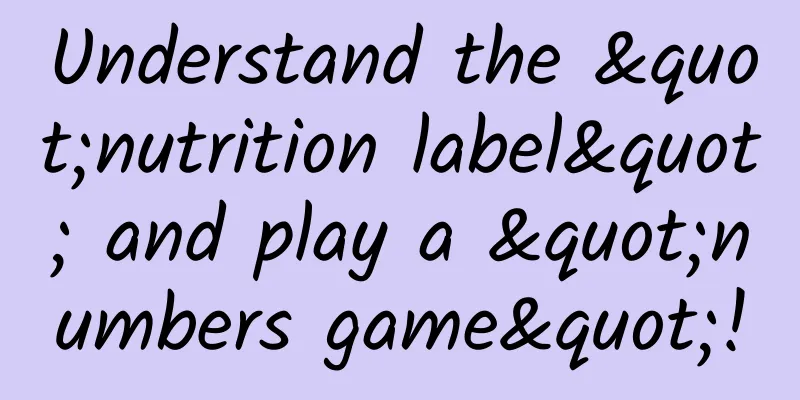Understand the "nutrition label" and play a "numbers game"!

|
Potato chips have more protein than milk! Is this nutrition label correct? What other weird things have you seen on nutrition labels? Leave a comment in the comments section! Last time, I introduced food labels to you. They are mainly related to food quality and precautions. Their characteristics are that they have a lot of text and a variety of expressions. Trying to understand them is like playing a "word game". Nutrition labels are different. They are mainly related to nutritional value and are characterized by a large number of numbers, like a "numbers game." The standard followed by nutrition labels is "GB28050-General Rules for Nutrition Labeling of Pre-packaged Foods", which is mainly divided into three parts: nutrition ingredient table, nutrition claims, and functional claims. What everyone is more familiar with is the Nutrition Facts Table, so let's start with it. There is a lot of content, so I suggest you click to follow and save it for later reading! What must appear on the nutrition facts table are: energy, plus the five core nutrients of protein, fat, carbohydrates and sodium, and their corresponding nutrient reference value percentages (NRV%). If food ingredients contain or hydrogenated and/or partially hydrogenated fats are used in the production process, the content of trans fat (acid) should also be indicated in the nutrition label. Vitamins, minerals, and more than a dozen other nutrients can be selectively labeled. Here comes a term called Nutritional Reference Value (NRV), which is defined as: a reference value used specifically for food nutrition labels to compare the nutritional content of food. That is, a set of numbers set by humans. There is a table in the national standard that records the values of various NRVs. However, when it is actually marked on the nutritional table and used in daily life, the main thing to look at is NRV%, which is the percentage of a certain nutrient in the daily requirement of an adult. The calculation of NRV% is also very simple, which is to divide the content of the ingredients marked on the nutritional information table by the corresponding value found in the national standard. For example, 100 ml of milk protein is about 3.3g, and the protein NRV is 60g, so the NRV% of 100 ml of milk is 3.3g/60g=5.5% NRV% represents the contribution of a food to nutrient intake and is also a reference indicator for evaluating how much of this food should be eaten. For example, it is not recommended to eat ingredients such as sodium, fat, and energy in excess of NRV. Therefore, if the NRV% of sodium in 100 grams of a certain food is 50%, that is to say, if you eat 100 grams of this food, you will consume half of your daily sodium intake. Obviously, the sodium content of this food is too high and you should eat less. Numbers Game 1: Pay attention to unit mass Here I would like to remind everyone that when reading the nutritional label, you must remember to check the mass or volume above, otherwise you will fall into the merchant’s trap! A typical example is potato chips. Numerically speaking, the energy and fat content on the nutrition facts table is not that high, but if you look closely, you will find that it is the nutritional content of "per serving" of potato chips, and this "per serving" is only about 30 grams (a bucket of potato chips is about 105 grams). If you convert it according to the nutritional content marked per 100 grams of most products, you will find that the fat content of potato chips is as high as 33%, which is really fattening. Numbers Game 2: Calculating Nutrient Density Seeing this, careful friends may have another discovery, which is the question I asked you at the beginning. If you convert it, you will find that the protein content of potato chips is as high as 5g/100g, which is much higher than the 3.3g/100g of milk! Has the nutrition information table overturned everyone's traditional cognition? Here I would like to talk about another concept called nutrient density. The academic formula for calculating nutrient density is relatively complicated. For ease of use, when comparing the content of a certain nutrient in different foods, you can simplify the following formula: For example, compare the nutritional information table: ● Potato chips, 100 grams of protein content 5 grams, energy 2266 kilojoules ● Milk, 100 grams contains 3.3 grams of protein and 276 kilojoules of energy. Simply comparing the protein content, potato chips appear to be more nutritious than milk, which is contrary to common perception! However, if you calculate the protein density, you will find that under the same energy intake, the protein density of milk is 0.012, while that of potato chips is 0.0022. The density of milk protein is about 5 times that of potato chips, which is consistent with everyone's cognition. It can be seen that simply looking at the content may be misleading. A more scientific method is to divide the content value on the nutritional table by the energy value, calculate the nutrient density and then compare. Does it seem that NRV is not very useful? This is not the case, because the other two elements in the nutrition label: "nutrition claim" and "functional claim" all rely on NRV! The definition of nutrition claim is: description and declaration of the nutritional characteristics of food, such as energy level, protein content level, including content claim and comparative claim. What we hear more often in daily life are content claims, such as "sugar-free", "0 fat", "high protein", etc., among which NRV is used. For example, per 100g of food: Protein content ≥10% NRV can be labeled "contains protein", Protein content ≥20% NRV can be called "high protein" or "protein rich" The content claims of vitamins and minerals are similar and are calculated with reference to NRV. Therefore, NRV is very useful when making content claims. Of course, for the claims about fat, sugar and sodium, specific values are still referenced. Please refer to the relevant content in GB28050 for details. The second type of claim is the nutrient function claim, which is defined as a claim that a certain nutrient can maintain normal growth, development and normal physiological function of the human body. When the content of a certain nutrient reaches the level of "contains" or "rich in", functional claims can be made on the food packaging to emphasize the health characteristics of the food. For example, "protein helps tissue formation and growth" and so on. So if you see these "functional claims" on food packaging, don't hesitate, take this product home quickly, it must be very nutritious! Nutrition labeling is a relatively complex systematic project. For ordinary consumers, we summarize the following points: ① Pay attention to the NRV% on the nutritional information table. For ingredients that need to be controlled, such as energy, fat, sugar, and sodium, a smaller NRV% is better. For nutrients that need to be supplemented, such as protein, dietary fiber, and vitamins, a larger NRV% is better. ② When comparing two different foods, you should first look at the "unit mass" on the nutritional table, and convert them to 100g for comparison. It is also recommended to calculate the nutrient density and choose the one with a higher nutrient density to avoid the embarrassing situation of "potato chips have more protein than milk". ③ Pay attention to "content claims" such as "0 fat" and "high protein". If "functional claims" are made at the same time, then this product is likely worth choosing! |
<<: Drinking coffee may reduce risk of acute kidney injury
Recommend
What causes bleeding gums during pregnancy?
Many female friends whose gums are normally healt...
How old is a woman's sexual function?
Both women and men have sexual desires, and the d...
What is the method of home-cooked boiled fish? How to make the boiled fish fillet tender and smooth?
Chongqing boiled fish is one of the representativ...
What is a physiological ovarian cyst?
The so-called ovarian cyst refers to a cystic tum...
Can I check my vaginal discharge the next day after my period ends?
Many women think that discharge is harmless, as l...
Is there any case of cervical dilation without pain?
When a woman is about to give birth, the cervix w...
My aunt is very dark, what's wrong?
In addition to observing whether each menstrual p...
Causes of low platelets in late pregnancy
Low platelet count in pregnant women has a great ...
How long does it take for the cystic dark area to turn into a gestational sac?
The gestational sac is the initial embryonic tiss...
Can vaginal ultrasound be done for vaginal bleeding?
Vaginal ultrasound means the same as its name mea...
Does the increase of vaginal discharge mean that I am pregnant?
During pregnancy, although there is no menstruati...
Don’t be confused when you go to the doctor! What diseases does the endocrinology department treat? Many people don’t know
When it comes to what diseases the endocrinology ...
What are the dangers of drinking less water during pregnancy?
As we all know, pregnant women should pay attenti...
How many pills of vitamin C should pregnant women take a day
Generally speaking, some pregnant women may be de...
Normal weight for women
There is a standard weight for each age group. Be...









